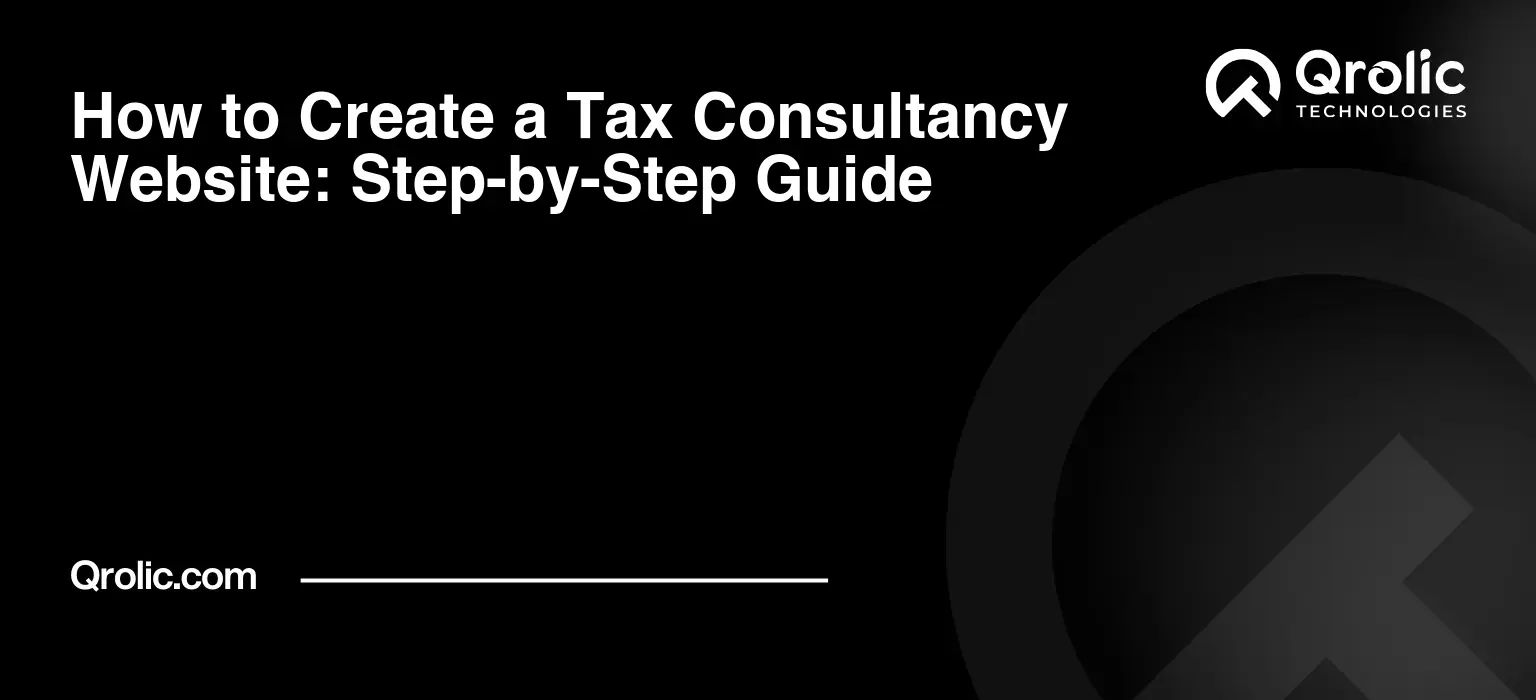Quick Summary:
- Plan your website: define niche, goals, and domain.
- Build a professional, user-friendly, and secure site.
- Create valuable content, optimize, and promote online.
- Maintain your site and ensure legal compliance.
Table of Contents
- 1. Laying the Foundation: Planning Your Tax Consultancy Website
- 1.1. Defining Your Niche and Target Audience
- 1.2. Defining Your Website’s Goals
- 1.3. Choosing a Domain Name
- 1.4. Selecting a Web Hosting Provider
- 2. Design and Development: Building Your Website
- 2.1. Choosing a Website Platform (CMS)
- 2.2. Selecting a Theme: Creating a Professional Look
- 2.3. Essential Plugins: Enhancing Functionality
- 2.4. Designing Key Pages: Creating a User-Friendly Experience
- 3. Content Creation: Attracting and Engaging Your Audience
- 3.1. Keyword Research: Identifying Relevant Terms
- 3.2. Creating High-Quality Content: Providing Value to Your Audience
- 3.3. Optimizing Content for SEO: Improving Search Engine Rankings
- 4. Marketing and Promotion: Driving Traffic to Your Website
- 4.1. Search Engine Optimization (SEO): Organic Traffic
- 4.2. Social Media Marketing: Engaging with Your Audience
- 4.3. Email Marketing: Nurturing Leads and Building Relationships
- 4.4. Paid Advertising (PPC): Driving Targeted Traffic
- 4.5. Local SEO: Attracting Local Clients
- 5. Maintenance and Optimization: Keeping Your Website Fresh and Effective
- 5.1. Regular Website Updates: Ensuring Security and Functionality
- 5.2. Analyzing Website Traffic and User Behavior: Identifying Areas for Improvement
- 5.3. Gathering and Responding to User Feedback: Improving User Experience
- 6. Legal Considerations: Ensuring Compliance
- 6.1. Privacy Policy: Protecting User Data
- 6.2. Terms of Service: Defining Website Usage
- 6.3. Disclaimers: Providing Transparency
- 7. Qrolic Technologies: Your Partner in Digital Success
- 8. Conclusion: Your Path to Online Success
1. Laying the Foundation: Planning Your Tax Consultancy Website
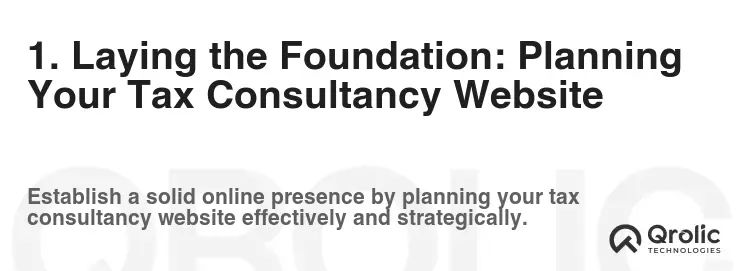
1.1. Defining Your Niche and Target Audience
Before a single line of code is written or a pixel is designed, you need to understand who you’re building this website for. Tax consultancy isn’t a monolithic block; it encompasses a wide range of specialties. Are you focusing on:
- Small Business Tax: Tailored for entrepreneurs, startups, and small enterprises. Keywords to consider: “small business tax returns,” “small business accounting,” “self-employed tax.”
- Individual Tax Planning: Geared towards individuals seeking help with personal income tax, deductions, and investments. Keywords: “individual tax preparation,” “tax planning services,” “personal tax accountant.”
- Corporate Tax Compliance: Aimed at larger corporations requiring assistance with complex tax regulations and filings. Keywords: “corporate tax compliance,” “international tax law,” “business tax advisor.”
- Expatriate Tax Services: Focusing on individuals living and working abroad. Keywords: “expatriate tax return,” “US expat taxes,” “foreign income tax.”
- Estate and Trust Tax: Dealing with tax implications related to inheritance and trusts. Keywords: “estate tax planning,” “trust tax preparation,” “inheritance tax advisor.”
Understanding your niche is crucial for several reasons:
- Targeted Content: You can create content that directly addresses the pain points and questions of your ideal clients. Imagine a small business owner searching for “how to deduct home office expenses.” If your website provides a clear, concise answer, you’ve instantly built credibility.
- Effective Marketing: Niche targeting allows you to focus your marketing efforts on platforms and channels where your target audience spends their time.
- Competitive Advantage: By specializing, you can differentiate yourself from larger, more general tax firms.
Actionable Tip: Conduct market research. Use tools like Google Keyword Planner, SEMrush, or Ahrefs to identify relevant keywords and analyze the competition within your chosen niche. Look at what your competitors are doing well (and where they’re falling short) and use that to inform your strategy. Don’t just guess; know your audience.
1.2. Defining Your Website’s Goals
What do you want your website to achieve? Is it purely a lead generation tool, a source of valuable information, or a platform for online consultations? Common goals for a tax consultancy website include:
- Generating Leads: Capturing contact information from potential clients. Keywords: “tax consultation,” “request a quote,” “contact tax advisor.”
- Building Brand Awareness: Establishing your firm as a trusted authority in the tax industry. Keywords: “tax expertise,” “tax planning resources,” “tax news and updates.”
- Providing Information: Offering valuable content to educate visitors and answer their questions. Keywords: “tax FAQs,” “tax tips,” “tax guide.”
- Selling Online Services: Offering services like tax return preparation or online consultations. Keywords: “online tax preparation,” “virtual tax consultation,” “file taxes online.”
- Recruiting New Employees: Attracting talented tax professionals to join your firm. Keywords: “tax accountant jobs,” “tax consultant careers,” “join our tax team.”
Actionable Tip: Define specific, measurable, achievable, relevant, and time-bound (SMART) goals. For example, “Increase lead generation by 20% in the next quarter.” This clarity will guide your website design and content strategy.
1.3. Choosing a Domain Name
Your domain name is your online identity. It should be:
- Memorable: Easy to remember and spell.
- Relevant: Reflect your brand and services.
- Short: Concise and easy to type.
- Available: Check domain availability using a domain registrar like GoDaddy or Namecheap.
- .com Preferred: While other extensions are available, .com is still the most recognized and trusted.
Actionable Tip: Brainstorm several domain name options and check their availability. Consider using your firm’s name, incorporating keywords related to your niche, or creating a catchy, brandable name. Avoid using hyphens or numbers unless absolutely necessary. For example: “YourTaxSolution.com” or “ABCAccountingFirm.com”.
1.4. Selecting a Web Hosting Provider
Your web hosting provider is like the real estate for your website. Choose a reliable provider that offers:
- Uptime Guarantee: Ensures your website is accessible to visitors 24/7. Aim for at least 99.9% uptime.
- Security Features: Protects your website from malware and cyber threats. Look for features like SSL certificates, firewalls, and regular backups.
- Scalability: Allows you to easily increase your website’s resources as your traffic grows.
- Customer Support: Provides timely and helpful assistance when you need it.
- Server Location: Choose a server location that is geographically close to your target audience for faster loading times.
Actionable Tip: Research different web hosting providers and compare their pricing, features, and customer reviews. Popular options include Bluehost, SiteGround, HostGator, and WP Engine. Consider a managed wordpress hosting solution for easier website management.
2. Design and Development: Building Your Website
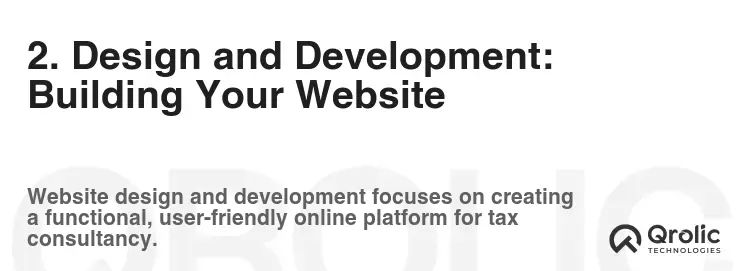
2.1. Choosing a Website Platform (CMS)
A Content Management System (CMS) simplifies website creation and management. The most popular CMS is WordPress, known for its flexibility, ease of use, and extensive library of plugins and themes.
Why WordPress is Ideal for Tax Consultancies:
- SEO-Friendly: WordPress is designed with SEO in mind, making it easier to optimize your website for search engines.
- Customizable: Thousands of themes and plugins allow you to create a website that perfectly matches your brand and needs.
- User-Friendly: The intuitive interface makes it easy to create and manage content, even without technical skills.
- Scalable: WordPress can handle websites of all sizes, from small business sites to large corporate portals.
- Secure: With regular updates and security plugins, WordPress can be secured effectively.
Alternative CMS Options:
- Squarespace: A drag-and-drop website builder, ideal for simple websites with limited functionality.
- Wix: Similar to Squarespace, offering a user-friendly interface and a wide range of templates.
- Joomla: A more complex CMS than WordPress, suitable for larger websites with custom requirements.
Actionable Tip: Unless you have specific needs that require a different platform, WordPress is generally the best choice for a tax consultancy website.
2.2. Selecting a Theme: Creating a Professional Look
Your website’s theme determines its visual appearance and layout. Choose a theme that is:
- Professional: Reflects the credibility and trustworthiness of your firm.
- Responsive: Adapts to different screen sizes (desktops, tablets, smartphones).
- SEO-Optimized: Designed with SEO best practices in mind.
- Fast-Loading: Doesn’t slow down your website’s performance.
- Customizable: Allows you to easily change colors, fonts, and layouts.
Recommended WordPress Themes for Tax Consultancies:
- Astra: A lightweight and highly customizable theme known for its speed and SEO optimization.
- OceanWP: Another popular theme with a wide range of features and customization options.
- Divi: A powerful drag-and-drop theme builder that allows you to create custom layouts without coding.
- Avada: A versatile theme with a wide range of pre-built demos and customization options.
Actionable Tip: Browse theme marketplaces like ThemeForest or the WordPress theme directory to find a theme that suits your brand and needs. Pay attention to customer reviews and ratings before making a purchase. Look for themes designed specifically for business or financial services.
2.3. Essential Plugins: Enhancing Functionality
WordPress Plugins add extra features and functionality to your website. Essential plugins for a tax consultancy website include:
- SEO Plugin (Yoast SEO or Rank Math): Helps you optimize your website for search engines. Keywords integration and analysis is key here.
- Contact Form Plugin (Contact Form 7 or WPForms): Allows visitors to easily contact you.
- Security Plugin (Sucuri Security or Wordfence): Protects your website from malware and hacking attempts.
- Caching Plugin (WP Rocket or W3 Total Cache): Improves Website Speed and performance.
- Analytics Plugin (Google Analytics Dashboard for WP): Tracks website traffic and user behavior.
- Live Chat Plugin (Tawk.to or LiveChat): Allows you to provide instant support to visitors.
- Backup Plugin (UpdraftPlus or BackupBuddy): Creates regular backups of your website.
- SSL Certificate Plugin (Really Simple SSL): Helps you install and configure your SSL certificate.
Actionable Tip: Install only the plugins you need and keep them updated to ensure optimal performance and security. Don’t overload your website with unnecessary plugins. Regularly review your plugins and remove any that are no longer needed.
2.4. Designing Key Pages: Creating a User-Friendly Experience
Your website should have several key pages that provide essential information to visitors. These include:
- Homepage: The first page visitors see. It should clearly communicate what you do and why they should choose you. Include a compelling headline, a brief overview of your services, and a call to action (e.g., “Get a Free Consultation”).
- About Us: Tells your story and builds trust. Include information about your firm’s history, mission, values, and team members. Showcasing expertise and experience is crucial.
- Services: Describes the services you offer in detail. Clearly outline the benefits of each service and include pricing information if possible.
- Testimonials: Features positive feedback from satisfied clients. Testimonials are powerful social proof that can help build trust and credibility. Use real photos and names.
- Blog: Provides valuable content on tax-related topics. A blog can help you attract organic traffic, establish yourself as an authority, and engage with your audience.
- Contact Us: Provides multiple ways for visitors to contact you, including a contact form, phone number, email address, and physical address. Include a map if you have a physical office.
- Privacy Policy: Explains how you collect, use, and protect visitor data. This is legally required in many jurisdictions.
- Terms of Service: Outlines the terms and conditions of using your website and services.
- FAQ: Answers Frequently Asked Questions about your services.
Actionable Tip: Use high-quality images and videos to make your website visually appealing. Ensure your website is easy to navigate and that visitors can quickly find the information they need. Use clear and concise language and avoid jargon. Focus on addressing the user’s needs and pain points.
3. Content Creation: Attracting and Engaging Your Audience

3.1. Keyword Research: Identifying Relevant Terms
Keyword research is the foundation of your content strategy. It involves identifying the terms that your target audience is searching for online.
Tools for Keyword Research:
- Google Keyword Planner: A free tool from Google that provides keyword suggestions and search volume data.
- SEMrush: A comprehensive SEO tool that offers keyword research, competitor analysis, and website auditing.
- Ahrefs: Another popular SEO tool with similar features to SEMrush.
- Moz Keyword Explorer: A tool from Moz that provides keyword suggestions and difficulty scores.
- Ubersuggest: A free tool from Neil Patel that provides keyword suggestions and content ideas.
Actionable Tip: Focus on long-tail keywords (longer, more specific phrases) that have lower competition. For example, instead of targeting “tax preparation,” target “tax preparation for small businesses in [your city].”
3.2. Creating High-Quality Content: Providing Value to Your Audience
Your content should be:
- Informative: Provides valuable information and insights.
- Accurate: Ensures all information is up-to-date and correct.
- Engaging: Captures the reader’s attention and keeps them interested.
- SEO-Optimized: Uses relevant keywords to improve search engine rankings.
- Easy to Read: Uses clear and concise language and avoids jargon.
- Well-Structured: Uses headings, subheadings, and bullet points to improve readability.
Content Ideas for a Tax Consultancy Website:
- Blog Posts: Write about tax tips, tax law changes, and industry trends.
- Articles: Provide in-depth information on specific tax topics.
- Guides: Create comprehensive guides on tax planning, tax preparation, and other related topics.
- Infographics: Visually represent complex tax information.
- Videos: Create videos explaining tax concepts or answering frequently asked questions.
- Case Studies: Showcase your success in helping clients solve their tax problems.
- Webinars: Host webinars on tax-related topics to engage with your audience in real-time.
- E-books: Offer downloadable e-books on tax planning and other relevant topics in exchange for contact information.
Actionable Tip: Create a content calendar to plan and schedule your content creation efforts. Promote your content on social media and other channels. Track your content’s performance and adjust your strategy accordingly. Always double-check information for accuracy, as tax laws change frequently.
3.3. Optimizing Content for SEO: Improving Search Engine Rankings
SEO (Search Engine Optimization) is the process of optimizing your website to rank higher in search engine results pages (SERPs). Key SEO factors include:
- Keyword Usage: Use relevant keywords throughout your content, including in the title, headings, and body text.
- Meta Descriptions: Write compelling meta descriptions that encourage users to click on your search results.
- Image Alt Text: Add alt text to your images to describe them to search engines.
- Internal Linking: Link to other relevant pages on your website.
- External Linking: Link to authoritative websites to provide additional information and build credibility.
- Mobile-Friendliness: Ensure your website is mobile-friendly and responsive.
- Page Speed: Optimize your website for speed to improve user experience and search engine rankings.
- Schema Markup: Add schema markup to your website to provide search engines with more information about your content.
Actionable Tip: Use an SEO plugin like Yoast SEO or Rank Math to help you optimize your content for search engines. Monitor your website’s search engine rankings and traffic using Google Analytics and Google Search Console.
4. Marketing and Promotion: Driving Traffic to Your Website
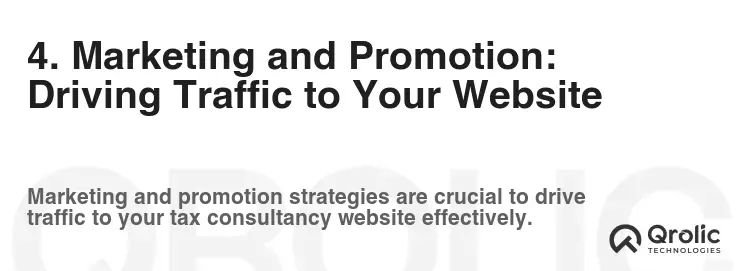
4.1. Search Engine Optimization (SEO): Organic Traffic
SEO is a long-term strategy that can drive significant organic traffic to your website.
Key SEO Strategies:
- On-Page Optimization: Optimizing your website’s content and structure for search engines.
- Off-Page Optimization: Building backlinks from other websites to improve your website’s authority and ranking.
- Technical SEO: Ensuring your website is technically sound and accessible to search engines.
- Local SEO: Optimizing your website for local search results (e.g., “tax accountant near me”).
Actionable Tip: Focus on providing high-quality content and building backlinks from reputable websites. Claim and optimize your Google My Business listing to improve your local search rankings.
4.2. Social Media Marketing: Engaging with Your Audience
Social media can be a powerful tool for promoting your website and engaging with your audience.
Effective Social Media Strategies:
- Choose the Right Platforms: Focus on the platforms where your target audience spends their time (e.g., LinkedIn for business owners, Facebook for individuals).
- Share Valuable Content: Share your blog posts, articles, guides, and other valuable content.
- Engage with Your Followers: Respond to comments and questions, participate in discussions, and run contests and giveaways.
- Use Relevant Hashtags: Use relevant hashtags to increase the visibility of your posts.
- Run Social Media Ads: Use social media ads to reach a wider audience and drive traffic to your website.
Actionable Tip: Create a social media calendar to plan and schedule your posts. Use social media analytics to track your performance and adjust your strategy accordingly.
4.3. Email Marketing: Nurturing Leads and Building Relationships
Email marketing can be an effective way to nurture leads and build relationships with potential clients.
Effective Email Marketing Strategies:
- Build an Email List: Offer a free e-book, guide, or other valuable resource in exchange for email addresses.
- Segment Your List: Segment your email list based on demographics, interests, and behavior.
- Send Targeted Emails: Send targeted emails that are relevant to each segment of your list.
- Personalize Your Emails: Personalize your emails with the recipient’s name and other information.
- Track Your Results: Track your email open rates, click-through rates, and conversion rates.
Actionable Tip: Use an email marketing platform like Mailchimp or Constant Contact to manage your email list and send emails. Comply with all email marketing regulations, such as GDPR and CAN-SPAM.
4.4. Paid Advertising (PPC): Driving Targeted Traffic
Pay-per-click (PPC) advertising can be a quick way to drive targeted traffic to your website.
Effective PPC Strategies:
- Choose the Right Keywords: Target keywords that are relevant to your business and have high search volume.
- Write Compelling Ad Copy: Write ad copy that is clear, concise, and compelling.
- Create Landing Pages: Create landing pages that are optimized for conversions.
- Track Your Results: Track your ad performance and adjust your campaigns accordingly.
Actionable Tip: Use Google Ads to run PPC campaigns on Google search and the Google Display Network. Consider using retargeting ads to reach visitors who have previously visited your website.
4.5. Local SEO: Attracting Local Clients
Local SEO is crucial for attracting clients in your geographic area.
Effective Local SEO Strategies:
- Claim and Optimize Your Google My Business Listing: This is the most important step for local SEO.
- Get Listed in Online Directories: List your business in online directories like Yelp, Yellow Pages, and Bing Places for Business.
- Encourage Customer Reviews: Encourage your customers to leave reviews on Google and other platforms.
- Use Local Keywords: Use local keywords throughout your website content and meta descriptions.
- Get Local Citations: Get your business name, address, and phone number (NAP) listed on local websites.
Actionable Tip: Use a local SEO tool like Moz Local or BrightLocal to manage your local listings and track your performance.
5. Maintenance and Optimization: Keeping Your Website Fresh and Effective
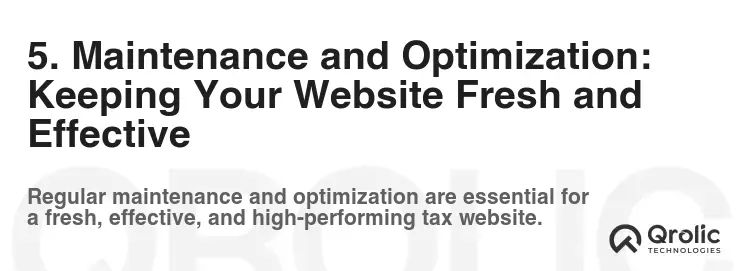
5.1. Regular Website Updates: Ensuring Security and Functionality
- Update WordPress Core, Themes, and Plugins: Regularly update your WordPress core, themes, and plugins to ensure security and functionality. Outdated software can be vulnerable to security threats.
- Monitor Website Performance: Use tools like Google PageSpeed Insights to monitor your website’s performance and identify areas for improvement.
- Test Your Website Regularly: Test your website on different devices and browsers to ensure it is working properly.
Actionable Tip: Schedule regular website maintenance tasks to ensure your website is secure, functional, and performing optimally.
5.2. Analyzing Website Traffic and User Behavior: Identifying Areas for Improvement
- Use Google Analytics: Use Google Analytics to track website traffic, user behavior, and conversions.
- Analyze Your Data: Analyze your data to identify areas where you can improve your website’s performance. For example, you might find that certain pages have high bounce rates, indicating that the content is not engaging.
- Make Data-Driven Decisions: Use your data to make informed decisions about your website’s design, content, and marketing strategy.
Actionable Tip: Set up goals in Google Analytics to track conversions and measure the success of your website.
5.3. Gathering and Responding to User Feedback: Improving User Experience
- Solicit Feedback: Ask your visitors for feedback on your website. You can use surveys, contact forms, or live chat.
- Respond to Feedback: Respond to all feedback, even negative feedback. Show your visitors that you value their opinions.
- Implement Changes: Implement changes based on user feedback to improve the user experience.
Actionable Tip: Create a system for gathering and responding to user feedback. This will help you continuously improve your website and provide a better experience for your visitors.
6. Legal Considerations: Ensuring Compliance
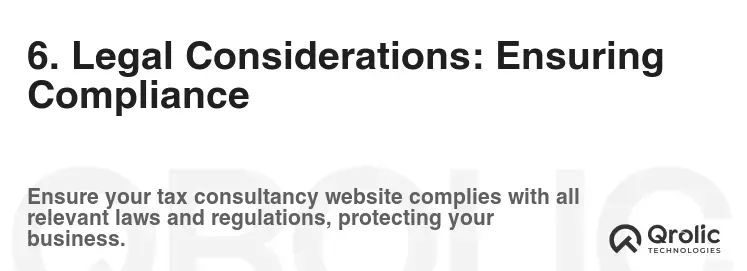
6.1. Privacy Policy: Protecting User Data
- Comply with Privacy Laws: Comply with all applicable privacy laws, such as GDPR and CCPA.
- Be Transparent: Be transparent about how you collect, use, and protect user data.
- Provide Users with Control: Give users control over their data. Allow them to access, correct, and delete their data.
Actionable Tip: Consult with an attorney to ensure your privacy policy is compliant with all applicable laws.
6.2. Terms of Service: Defining Website Usage
- Clearly Define Website Usage: Clearly define the terms and conditions of using your website.
- Limit Liability: Limit your liability for any damages that may result from the use of your website.
- Protect Your Intellectual Property: Protect your intellectual property by including copyright and trademark notices.
Actionable Tip: Consult with an attorney to ensure your terms of service are legally sound.
6.3. Disclaimers: Providing Transparency
- Provide Disclaimers: Provide disclaimers to inform visitors that the information on your website is for general informational purposes only and should not be considered legal or financial advice.
- Specify Limitations: Specify any limitations on the information provided on your website.
- Consult a Professional: Advise visitors to consult with a qualified professional before making any financial decisions.
Actionable Tip: Consult with an attorney to ensure your disclaimers are adequate and protect you from liability.
7. Qrolic Technologies: Your Partner in Digital Success

Qrolic Technologies (https://qrolic.com/) is a full-service digital marketing agency that can help your tax consultancy firm achieve its online goals. We offer a wide range of services, including:
- Website Design and Development: We create stunning, user-friendly websites that are optimized for search engines and conversions.
- Search Engine Optimization (SEO): We help you rank higher in search engine results pages (SERPs) to attract more organic traffic to your website.
- Pay-Per-Click (PPC) Advertising: We run targeted PPC campaigns that drive qualified leads to your website.
- Social Media Marketing: We help you build a strong social media presence and engage with your audience.
- Content Marketing: We create high-quality content that attracts and engages your target audience.
- Email Marketing: We help you nurture leads and build relationships with potential clients through email marketing.
Why Choose Qrolic Technologies?
- Expertise: We have a team of experienced digital marketing professionals who are experts in their fields.
- Results-Driven: We are focused on delivering results for our clients.
- Customized Solutions: We provide customized solutions that are tailored to the specific needs of each client.
- Transparent Communication: We are committed to transparent communication and keeping our clients informed every step of the way.
- Affordable Pricing: We offer competitive pricing that fits within your budget.
Let Qrolic Technologies help you build a successful tax consultancy website and achieve your online goals. Contact us today for a free consultation!
8. Conclusion: Your Path to Online Success
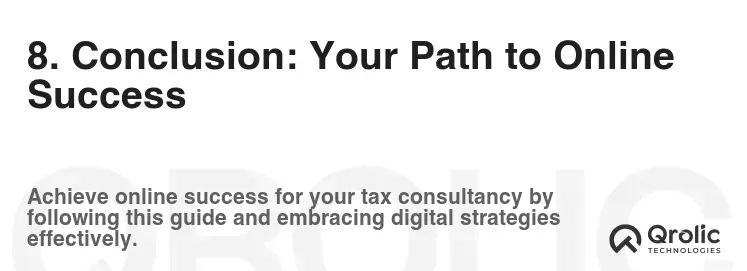
Creating a successful tax consultancy website requires careful planning, execution, and ongoing maintenance. By following the steps outlined in this guide, you can build a website that attracts and engages your target audience, generates leads, and establishes your firm as a trusted authority in the tax industry. Remember to focus on providing valuable content, optimizing your website for SEO, and promoting your website through various marketing channels. And don’t hesitate to seek help from experienced professionals like Qrolic Technologies to ensure your success.
